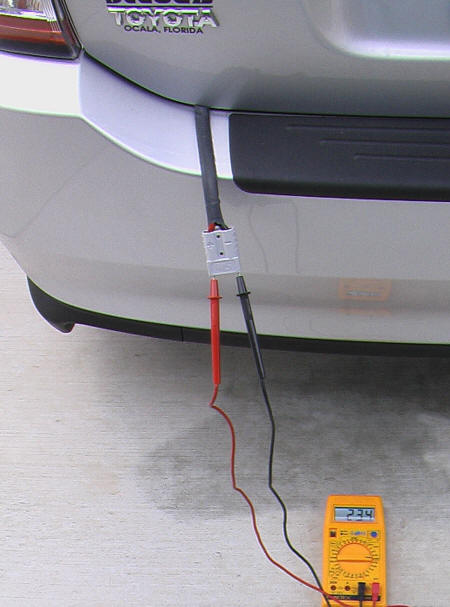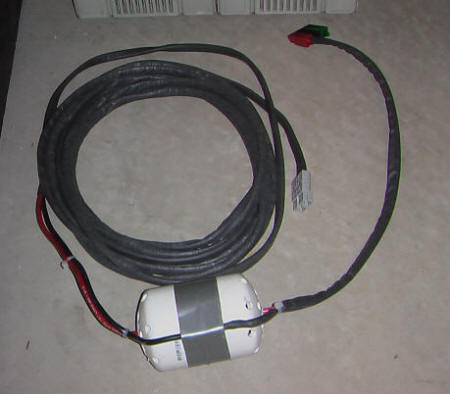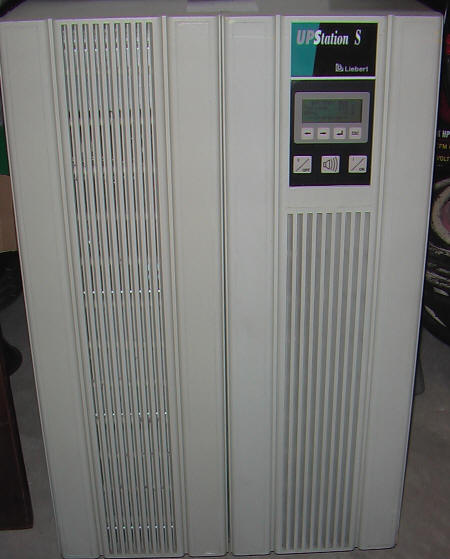 |
Chris's PriUPS
Chris Swinney, MD, a cardiac anesthesiologist, started working on his system last year, and sent me these photos in May of 2007. Chris tried the eBay route but had a disappointment. The UPS he bought didn't work, and he turned to a professional UPS refurbisher. He lives in Ocala, Florida, so it looks like he's finished his system just in time for an early hurricane season!
"OK, got a 10 KVA Liebert UPStation S for just under 3K delivered. (Refurbisher was all out of 12 KVA.) Equivocal results with starting the central A/C, but it runs everything else with ease.
The "extended battery connector" is VERY similar to the "matching pair" connectors we both used on the car end of the connection. I salvaged the one from the smoked UPStation and used it on the other end of the cable. The thing near the UPS end (with the multi-color connector) that looks like a float buoy is an insulating case around the isolation diodes. The diodes I found for cheap were "stud mount" type, which means a "live" heat sink, and the best compromise I could strike between insulation and ventilation (it shouldn't need much--I used a pair of 40A diodes to keep the forward voltage drop low) was a pair of 3" PVC pipe caps perforated with 3/8" vent holes and joined over a short stub of pipe.
I also thought you might like to add another option for UPS sourcing. I know my experience may not be representative, but after the eBay "smoke bomb," I found these guys to be very helpful and knowledgeable:
PEI (Power and Environment International)
Although (understandably) geared toward commercial and industrial customers, they were EXTREMELY patient, considerate, and spent quite a bit of time (mostly looking over your site) trying to understand what the heck I was trying to do and to do their best to deliver an item that would suit this offbeat use.
Here's a follow-up from Chris a couple of days later, which put me in the odd position of arguing as Devil's Advocate. Chris suggested offering a "virtual kit" with a parts list and sources for the components and equipment needed to make the system instead of ad hoc eBay purchases. My response, and his paean to the PriUPS follow. He's right, of course. I was simply parroting comments I had seen others make.
From: Richard Factor
Certainly having a "virtual kit" is a great idea,
although I wonder how many people would be willing
to invest real money in a UPS. The argument
would be "I can get a real generator for the same
(or much less for a small one) so why bother."
Richard,
I think PriUPS is superior to a generator in a number of ways:
You point out the elimination of "one more maintenance mouth to feed." I've
owned a few gensets; changing the oil is always miserable. It seems the
designers just assume you're going to abuse it and not change the oil, so why
make the drain plug accessible?
Even compared to the large, enclosed standby gensets, the Prius isn't merely
quieter, it is "attack submarine" quiet. I consider it a worthwhile trade that a
generator large enough to run the central A/C would probably be loud enough to
keep everyone (possibly including neighbors) awake all night, while the Prius is
barely louder than the cooling fans on the UPS. It will certainly run plenty of
fans reliably through the night. (We'd just block it in the driveway with our
other vehicle.)
I also think PriUPS is the most efficient home generator ever devised. The
engine is run at low-RPM, high-torque (about 1200 RPM and 80% of available
torque, per ScanGauge) like commercially available "inverter-generators."
However, it also uses storage batteries as a buffer and shuts the ICE down
entirely when possible, and the ICE is Atkinson cycle, which I doubt is ever
employed on ordinary gensets for reasons of weight and cost.
I haven't "clocked" the duty cycle of
PriUPS yet, but it seems to be no more than 50%, and per ScanGauge consumes
0.6-0.7 gallons per hour when running. A single tankful should last well more
than a day of continually powering the house!
Chris
 |
We have voltage! |
 |
This is the cable Chris made to connect the Prius (above) to the UPS battery. |
 |
Here is a detail of the isolation diodes. He used this small heatsink instead of putting them in a separate cabinet. |
 |
This is the used Liebert UPStation he selected instead of trying to
find one identical to mine. I think this is actually a better
choice, since its nominal battery voltage is 192V, lower than the 240V
of the Lucent unit I'm using, and much closer to the nominal voltage of
the Prius battery.
|
New 12 May 2007